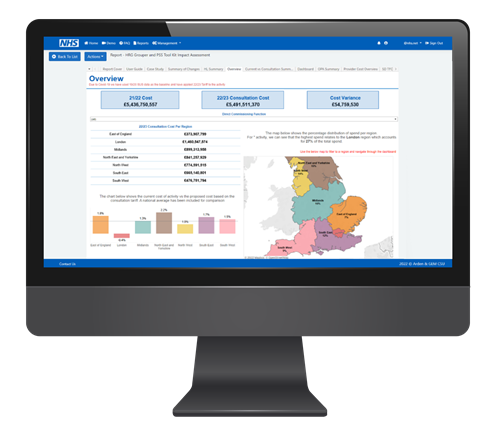The NCDR (National Commissioning Data Repository) consists of two elements: a data warehouse to store national data and a reporting portal.
The data warehouse is available to analytical staff within direct commissioning for interrogation in order to respond to ad-hoc requests and deep dives. The NCDR portal is a web-based application developed by Arden & GEM (for NHS England) primarily to support direct commissioning. The portal and its usage has developed over time to also address the wider reporting needs of other stakeholders (including healthcare providers and Integrated Care Boards). The NCDR is considered the central data repository and provides a ‘single version of the truth’ to support commissioning.
Reports within the portal enable both commissioners and providers to:
- Identify examples of poor data quality for targeted improvement
- Access relevant reports while adhering to information governance requirements
- Gain insight to facilitate informed decision-making
- Manage healthcare provider contracts
- Identify QIPP opportunities
- Identify unwarranted variation for further investigation
- Explore clinical pathways.
The NCDR brings together different data sources including Commissioning Data Sets (CDS) submitted to Secondary Uses Service (SUS Plus), Aggregate Contract Monitoring (ACM), Patient Level Contract Monitoring (PLCM), Drug PLCM, Device PLCM and Clinical Registries. The NCDR enables event linkage at a patient level, to enable monitoring of the entire patient pathway.
By accessing data and intelligence within the NCDR Portal, users are provided with a more comprehensive view of their landscape to underpin intelligent commissioning decisions. This allows for fully informed planning based on a more comprehensive understanding of the needs of their population.
Demonstrations of the NCDR Portal are held every month. Dates and joining details can be found on the Demo page in the Portal.
Stakeholders can request new report developments to meet their local needs. The reporting and automation team will work with you to understand the problem you are trying to address or the question you are trying to answer, to design an interactive reporting solution to meet those needs. Please contact dprusupport@nhs.net for more information.
Over 100 existing reports are available including:

SPECIALISED SERVICES
Distribution of Activity and Provider Eligibility List
Identifies patient flows and specialised service activity undertaken where the provider has not been commissioned to provide the associated service, irrespective of Prescribed Specialised Service (PSS) Toolkit criteria.
HRG and PSS Toolkit Impact Assessment
Highlights changes in activity found in new releases of the Healthcare Resource Grouper (HRG) and identifies the tariff increase for each region and/or changes in HRG allocation by applying the new HRG tariff software to existing activity. The report also highlights any changes made to the PSS Toolkit and the impact this has on commissioner allocations and attendances.
Key Lines of Enquiry (KLOE)
Identifies issues within the monthly ACM data submissions to help commissioners understand which services, settings and providers are of concern by reviewing activity trends, highlighting outliers and comparing activity against a baseline.
ICB Patient Flow Dashboard – Secondary Care Dental
Highlights patient flows for secondary care dental activity and identifies any activity undertaken outside of the patients registered ICB. The report is based on monthly ACM data.
National Cancer Report
Identifies activity flows and trends within the cancer pathway showing system recovery against: 2 week waits, 31 days, 62 days and 104 days. The report also identifies monthly outliers in diagnostic tests and trends in treatment outcomes and geographical flows.
Cystic Fibrosis Report
Designed as a week-by-week service overview dashboard for cystic fibrosis derived from SUS data. Tabs are split between Outpatient Activity, Unique Outpatients, Occupied Bed Days, Inpatient Activity, Inpatient Day Cases and A&E Activity, with filtering options to drill down to specific regions, providers and year on year comparisons.
Adult Critical Care Report
Designed as a capacity management and service overview system for adult critical care units. It provides capacity and demand reports, covering adult critical care services, by utilising data from the Directory of Services (DOS) platform, refreshed twice a day. There is a high-level overview of the whole service and users can filter by specific region, network, trust or unit to see a raft of visuals and metrics.
Highly Specialised Services (HSS)
Provides summary information on all the services in the highly specialised services portfolio and detailed information on selected services. Also includes a list of expert centres delivering the service, a measure of the activity that the service undertakes, clinical outcomes from the service and information about geographical equity of access to the service.
Referral to Treatment (RTT)
Looks at consultant-led Referral to Treatment (RTT) waiting times in weeks, split by treatment function for the different pathways: Completed Pathways, Incomplete Pathways, Incomplete Pathways with Decision to Admit (DTA) and New RTT Patients (New Clock Starts). The report is refreshed monthly and there are options to filter by region and provider.

SPECIALISED MENTAL HEALTH SERVICES
Specialised Mental Health Finance and Contracting Dashboard
Costed specialised mental health data analysed at provider and provider collaborative level. The report allows provider collaboratives to monitor their activity and spend and supports the repatriation of patients by exploring the volume of patients not receiving care within their local area and/or providers and the cost implications of this.
Service Specific Specialised Mental Health Activity Dashboards
Allows multiple measures to be explored at provider, regional or service type footprints including admissions, length of stay, delayed discharges, readmission rates and patients treated outside of their natural clinical flow. Identifies outliers and variation within each measure.
DRUGS
Drugs Budget Report
Allows users to monitor drugs spend against plan at both provider and National Programme of Care (NPoC) level. Individual drugs can be selected to view year to date costs and trends from previous years. The ACM vs Drugs tabs highlights differences between the two datasets.
Cancer Drug Fund (CDF) Blueteq Reconciliation Report
Contains all CDF Minimum Dataset (MDS) information, with associated allocation details and validation check results, summarised by provider, cost and overview of validation errors. Any patients with an approval date in the patient request file that do not appear in the MDS are identified.

HEALTH AND JUSTICE
Health and Justice (H&J) Dashboards for Adult, Immigration Removal Centres (IRC) and Children and Young People’s Secure Estate (CYPSE)
These reports monitor and analyse performance indicators for the secure estate using data extracted directly from TPP SystmOne. Monthly data is available from April 2021 and can be viewed at region, service provider, site, age and ethnicity level for detailed analysis.
H&J Sexual Assault and Referral Centres (SARC) Dashboard / RMDS (Reconnect)
These reports provide an analysis of monthly service submissions against national key performance indicators. Activity can be compared by region, providers, site, personal demographics and other metrics. Data is available from April 2022.
H&J Liaison and Diversion Indicators of Performance (LDIP) Dashboard / FfIC (Framework for Integrated Care)
These reports provide an analysis of quarterly service submissions against national key performance indicators. Activity can be compared by region, providers, site, personal demographics and other metrics. Data is available from April 2022.

ARMED FORCES
Veterans Mental Health Services
The TILS (Transition, Intervention and Liaison Service) and CTS (Complex Treatment Service) reports allow commissioning managers to monitor referrals by military service, ethnicity, age range and gender as well as understand waiting times and outcomes by region and provider.
Armed Forces Contract Monitoring Report
Monitors the secondary care activity commissioned by NHS England for military personnel. It provides variances for activity and spend against plans by provider, POD (Point of Delivery) and TFC (Treatment Function Code) and displays trends in activity and spend as well as highlighting activity not attributable to armed forces personnel.

PROVIDERS
Compliance Data Quality Report
Shows the performance of the population and quality of data items in the core datasets (ACM, PLCM, Drugs, Devices) and non-core datasets (such as Cancer Drug Fund and Limb Prosthetics). For each item it displays which items have failed quality checks and the number of instances based on adherence to the formats and standards in the national specifications. It also provides advice regarding what is required to correct the submissions.
Reconciliation Report
Highlights the differences in the Admitted Patient Care Services (APCS), Outpatient Attendances (OPA) and Accident and Emergency (A&E) submissions to SUS compared with the inpatient, outpatient and A&E PODs within the PLCM submission. This enables providers to implement the changes required to ensure the separate submissions match.

Why the NCDR?
- Access data and analysis to complete your overview of your commissioning landscape
- Take a system-wide view for improved planning at different levels
- Accurate and timely identification of unwarranted variation between providers
- Financial diagnostics that highlight inefficiencies and present opportunities for savings
- Tailored intelligence to highlight unwarranted variation in clinical indicators that can be used to improve patient experience and outcomes
- A simple, intuitive and customisable portal
- Self-service capabilities
- Comprehensive training, resources and support available to ensure your organisation gains the maximum value from the portal.
The NCDR provides a single source of truth, enabling commissioning managers to collaborate, track trends, benchmark performance and make informed decisions based on a more comprehensive understanding of the needs of their population. It provides an understanding of spend on patients and financial diagnostics that highlight inefficiencies and present opportunities for tangible savings.
We continually review and invest in the NCDR Portal and its reports to evolve information and insight to meet the changing needs of commissioners and providers. The input of users and partners ensures we focus on the data and intelligence required to deliver efficiency and improvements in patient care.
The NCDR Portal is used to identify and deliver millions of pounds in savings within services directly commissioned by NHS England and is a vital tool in managing contracts against budgets. In 2021/22 NCDR Portal data supported NHS England to challenge over £500m of expenditure on drugs with providers.
Register for and access the NCDR Portal here.
RELEVANT READING
Find out more about the NCDR portal by accessing the resources below.
CONTACT US
For more information, including NCDR development plans, or to request new reporting outputs, please contact us here:










